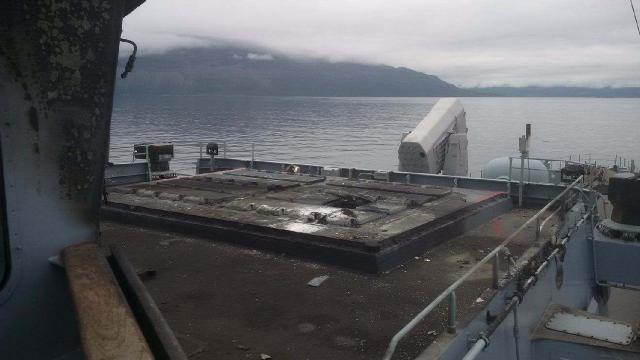It was a doomed week for Germany: between Chancelor Angela Merkel being given a lease on borrowed time on the one hand and the elimination of the Mansschaft from the World Cup in Russia on the other, the only other missing disaster had to be a near catastrophe in the Sea of Norway, only thwarted thanks to the skills of the German Sachsen frigate's crew members.
Thus, the old wise saying « Never two without three! » is proved on both side of the Rhine…

The Air Defense frigate Sachsen (Class F219 Sachsen).
The Sachsen (F219), one of the iconic frigates of the Deutsche Marine, was participating in a firing campaign in a dedicated test range in the Norwegian Sea, when the mislaunch of an SM-2 Surface to Air missile triggered an explosion in the forward part of the vessel, right at bridge level over the launching silos.
Miraculously only two sailors got lightly stunned, but could quickly resume duty.
In a video shot from the second frigate, a loud explosion can be seen and heard, followed by impressive flame burst ans subsequent billowing smoke. Watching the video also shows how fast and effective the ship's safety system was at extinguishing and controlling the fire.
Video : This video allows measure the time that was necessary to control the fire.
An inquiry has been ordered to determine the origins of this rather rare accident.
Though it is too early to understand the causes of this firing mishap, according to Cmdr. Patrice Théry (R) two questions need to be addressed: “is the incident the consequence of a malfunction of the release device within the system that locks the missile in its launching tube or does the failure originate from the booster itself? Our expert believes that “the explosion was more likely caused by the booster than by the warhead. A warhead explosion would have had a massive destructive action with major collateral effects on the other silos”.

Top view of the VLS of SM-2 silos.
In any case, judging by this photo published by the Deutsche Marine “the state of the top surface of the SM2 VLS (Vertical Launch System) cluster is far from showing the stigma of a warhead explosion but rather more those that would be left by a massive blowtorch.”
One may remember in this context that “HMS Sheffield was lost in the Falklands not by the explosion of an Exocet which went through the ship portside to starboard without exploding but leaving its burning booster inside the ship… This shows the devastating effect of a blazing booster in an enclosed area…”
The Sachsen air defence frigate was with the ASW frigate Lübeck north of the polar circle. A first shot was fired without any noticeable problem and before a last check of the missile.

Firing of an SM-2 missile by Sachsen frigate.
On June 19, according to the Deutsche Marine website, in a paper signed from Harstad, information is provided on this coming exercise that also involved the logistic vessel Bonn, which is the former Admiral vessel of the Aegean NATO naval force. The three vessels actually left their Wilhemshaven home base on 18 June, heading for the Norwegian port of Harstad with the objective of testing their weapon systems and particularly their sea to air missiles and RAMs.
Under escort, the vessels sailed towards the Andoya Test center located at Norway’s extreme North, about 180 Nautical miles from the polar circle, an area where the sun shines 24 hours a day at this time of the year. The range is equipped with telemetry and target tracking systems. Drones are also available to maximise the quality of the tests.
After the accident, the vessels went back to Harstad harbour, primarily for damage assessment. It has not been revealed whether the second frigate was to resume, alone, her Mk 46 torpedo tests as originally planned.
In this second firing tests in Norway – a first campaign had taken place 2016, it is obvious that luck partnered with the cool reaction of the crew. Credit must also be given to the communication managers who, by rapidly putting this video on line, enabled the information to be rapidly picked up by the Asian media as well as by the so-called pro-Russian “re-information” websites. In sharp contrast there was not a single mention of the accident in Germany. Yet images were there and available…
In the context of naval affairs, tribute must be paid to French internet site Mer et Marine which gained substantial momentum in recent years thanks to its quality articles.
Comment from Eric H. Biass, technical defence editor:
The fact that the SM2 missile warhead did not detonate in those circumstances is because most large-calibre weapon warheads (almost anything above 40mm calibre – and this includes torpedoes and howitzer rounds) are equipped with a safety device that inhibits warhead detonation if the weapon has not travelled a determined safety distance from its launching/firing point. Such safety systems may be time- or acceleration-based – or both.
Joël-François Dumont
Useful links :
Frégate Sachsen : Lors de son lancement, un missile explose en mer de Norvège (2018-06-27)
Unfall auf der „Sachsen“: „Wir standen vor einer gleißenden Feuerwand“










